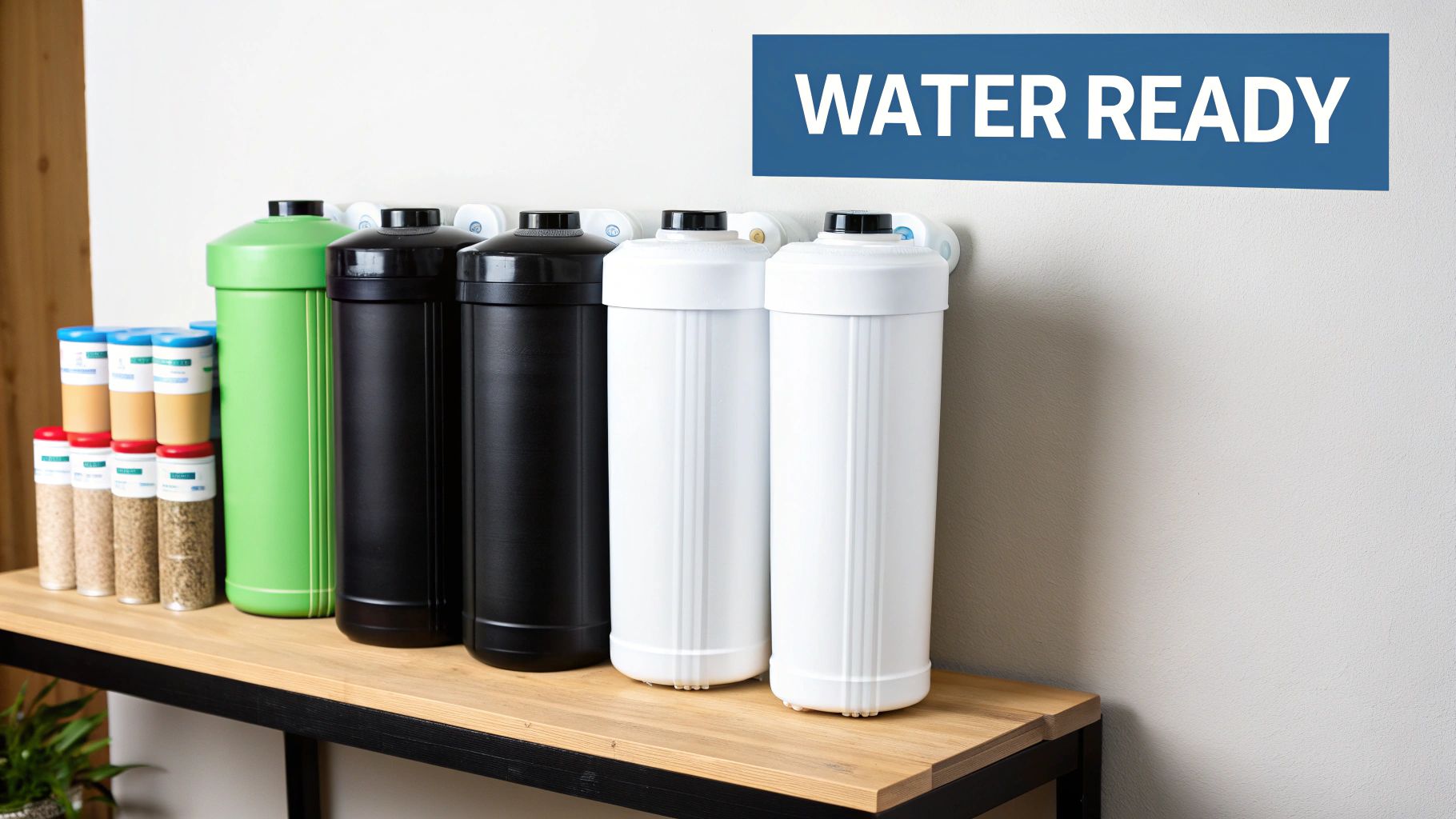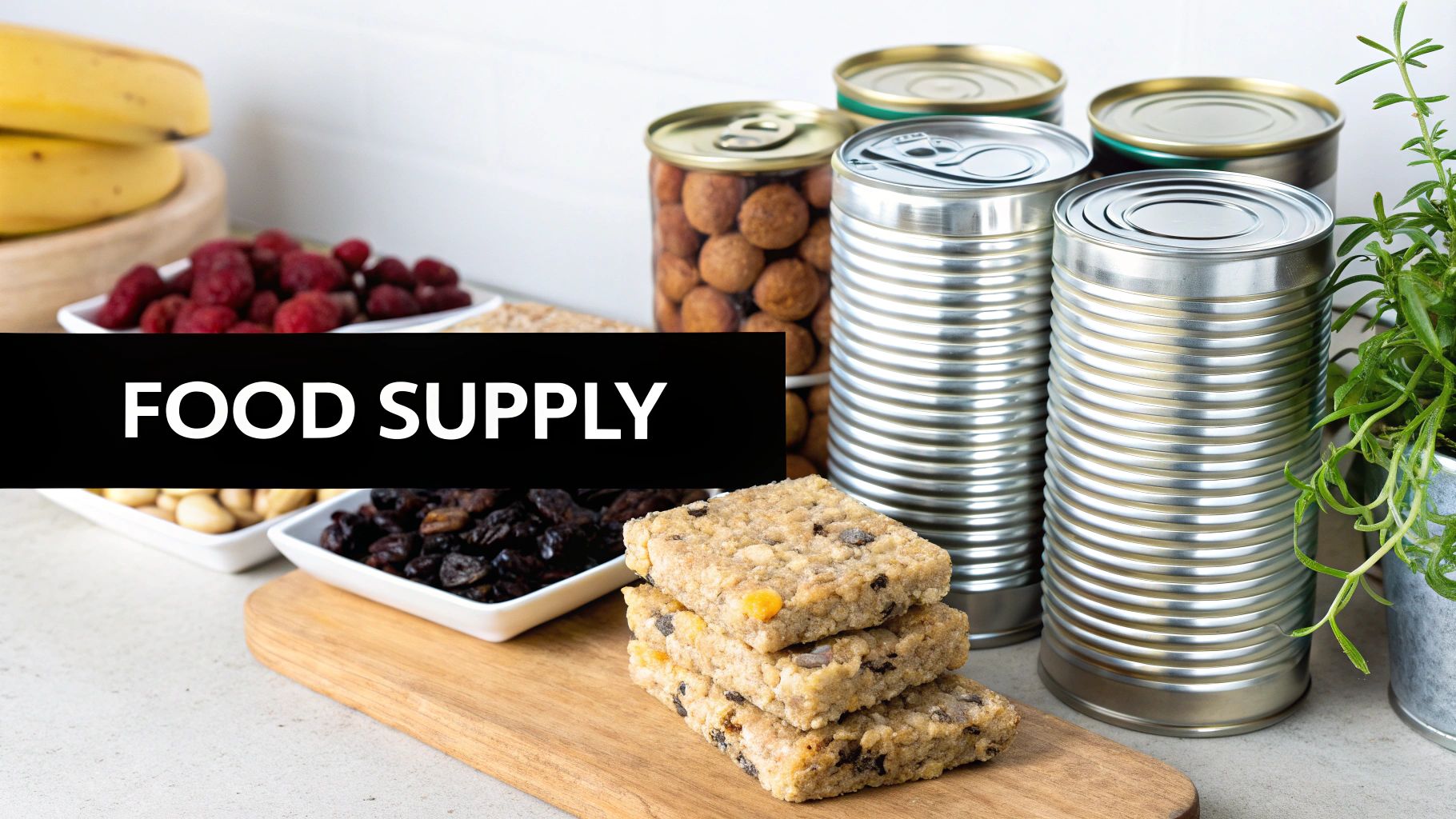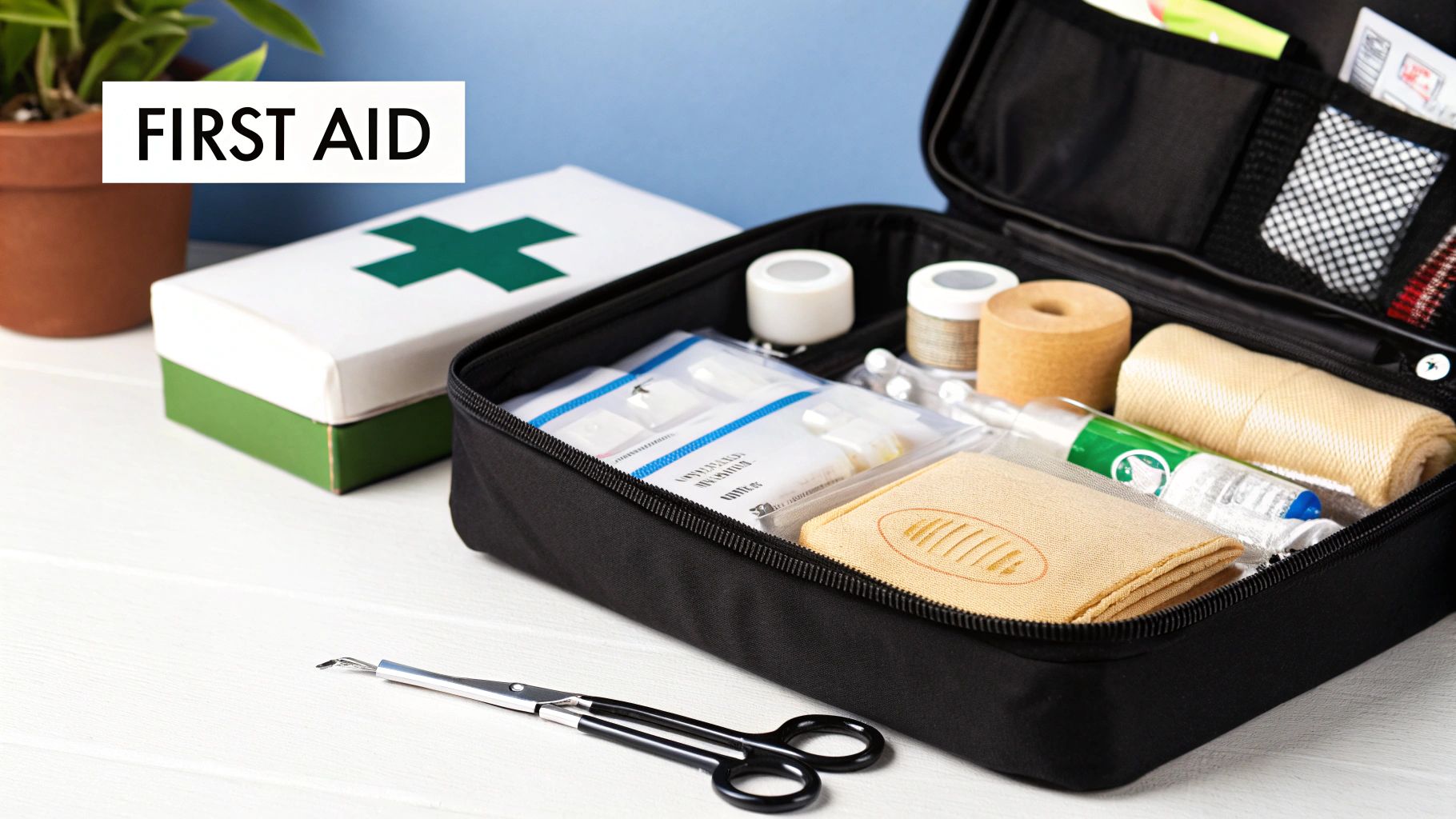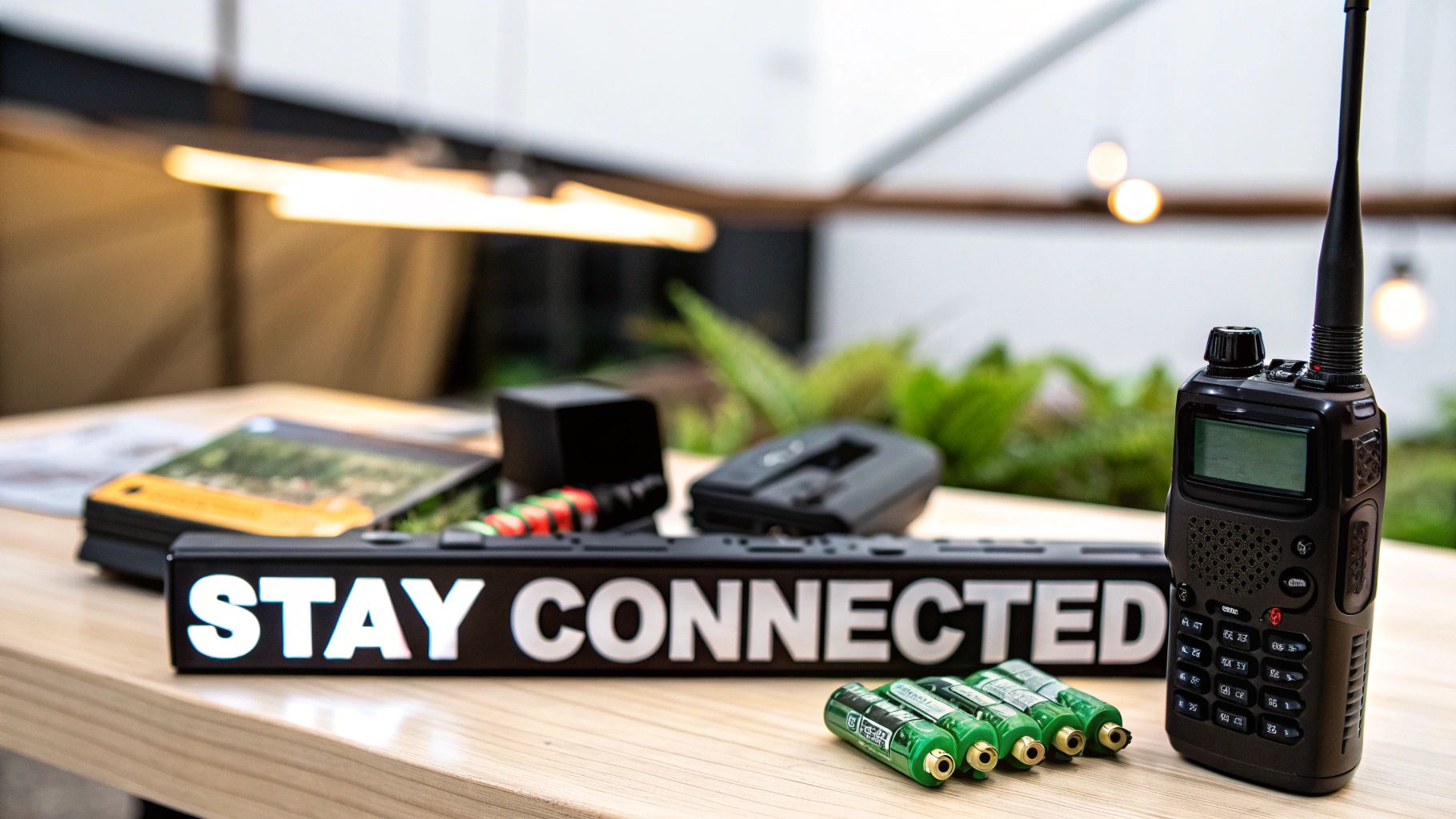Natural disasters, power outages, and unexpected crises can strike without warning, turning everyday life upside down in an instant. While we can't predict when an emergency will happen, we can control how we prepare for it. A well-thought-out plan isn't about paranoia; it's about empowerment. It’s the critical difference between panic and proactive response, chaos and control. This comprehensive emergency preparedness checklist is way more than just a list of items to buy and shove in a closet. Think of it as your strategic roadmap, designed to give you, your family, and your community the resilience to face the unexpected with confidence.
Throughout this guide, we'll break down the ten most critical areas of readiness. We'll move beyond just telling you what to get and focus on how to implement each step effectively. From establishing a sustainable supply of water and non-perishable food to assembling advanced first aid kits and securing reliable communication devices, every item is a building block for your safety. We’ll also cover essential strategies for creating a family communication plan and the importance of having critical documents and cash readily accessible. Understanding the fundamental importance of readiness is the first step, so it is vital to consider how to be prepared for any event that disrupts normal life. This detailed checklist will provide actionable insights to ensure you aren't just surviving an emergency, but are capable of navigating it safely and effectively. Let's build a foundation of safety, so you're ready for whatever comes next.
1. Emergency Water Storage and Purification
Water is the single most important resource in any emergency. While humans can survive for weeks without food, we can only last a few days without water. When a disaster strikes, like a hurricane or major freeze, municipal water systems can fail, leaving entire communities without a clean, reliable source. This makes having a personal water supply a non-negotiable part of any emergency preparedness checklist.

How to Store and Purify Water
Your water plan should have two key components: storage and purification.
Storage: The baseline recommendation is one gallon of water per person, per day, for at least three days. But let's be real, recent events like the 2021 Texas freeze prove that a 7 to 14-day supply is a much smarter goal. You can use commercially bottled water, which is simple and effective, or fill your own food-grade containers. For larger-scale water reserves, you might want to look into different types of polyethylene storage tanks that can hold a serious volume for long-term security. Just be sure to store your water in a cool, dark place away from sunlight and toxic stuff like gasoline or pesticides.
Purification: Stored water is your first line of defense, but you absolutely need backup methods. Keep purification tablets in your home kit, bug-out bags, and vehicles. High-quality portable filters, like those from LifeStraw or Sawyer, are essential for filtering water from questionable sources you might find yourself needing to use.
Pro Tip: Don't wait for a disaster to learn how your purification tools work. Take your filters and tablets on a camping trip or just test them in the backyard. The last thing you want is to be fumbling with instructions under stress.
2. Non-Perishable Food Supply
Right after water, a well-stocked supply of non-perishable food is a critical pillar of any effective emergency preparedness checklist. When a crisis disrupts supply chains, closes grocery stores, or knocks out the power, having immediate access to food is essential for keeping your energy, morale, and health up. A thoughtfully planned emergency food supply provides the calories and nutrition you need to get through stressful situations when your pantry is bare.

How to Build Your Emergency Food Supply
Building a reliable food reserve involves more than just grabbing extra canned goods; it takes a strategic approach to nutrition, storage, and rotation. Your goal is to stock up on foods that don't need refrigeration, require minimal prep, and offer balanced nutrition.
Caloric and Nutritional Needs: Plan for at least a three-day supply, but really, aim for a two-week reserve if you've got the space. A good baseline is about 2,000 calories per person, per day. Focus on a mix of macronutrients: carbs for energy (rice, pasta, crackers), proteins for strength (canned tuna, chicken, beans), and healthy fats (nuts, seeds, peanut butter). Don't forget to toss in some vitamin and mineral supplements to fill any nutritional gaps.
Storage and Rotation: Store your food in a cool, dry, and dark spot, ideally below 70°F, to make it last as long as possible. Use a "first in, first out" (FIFO) rotation system. When you buy new emergency food, stick it in the back and move the older items to the front. This way, you use stuff before it expires, keeping your supply fresh and avoiding waste. For long-term peace of mind, consider investing in specialized freeze-dried meal kits from brands like Augason Farms, which are designed to last for decades.
Pro Tip: Include familiar, comforting foods in your supply. Things like granola bars, peanut butter, and instant coffee can give you a huge psychological boost and a sense of normalcy during a high-stress event. Stress can kill your appetite, so having foods your family actually likes is a game-changer.
3. First Aid Kit and Medical Supplies
In any emergency, professional medical help can be delayed for hours or even days. A well-stocked and accessible first aid kit isn't just a box of bandages; it's a critical resource for treating injuries, managing medical conditions, and stopping minor issues from spiraling into major emergencies. Having the right supplies and the know-how to use them is a cornerstone of any effective emergency preparedness checklist, providing immediate care when seconds count.

How to Build and Maintain Your Medical Kit
A truly useful first aid kit goes beyond the basics and is tailored to your specific needs. It should be regularly maintained and, just as importantly, paired with proper training.
Build Your Kit: Start with a pre-made kit from a reputable brand, then customize it. Add a 7-day supply of any prescription medications, over-the-counter pain relievers, allergy meds, and any items specific to your family, like infant or elderly care supplies. Crucially, include trauma supplies like tourniquets and hemostatic gauze. In a severe bleeding event, knowing your complete guide to applying a tourniquet can literally be the difference between life and death.
Maintain and Train: A kit is worthless if its contents are expired or you don’t know how to use them. Check expiration dates every six months. More importantly, get trained. Taking a certified First Aid and CPR course gives you the confidence and skills to act decisively when it matters most. Keep smaller, portable kits in your car and at work for all-around readiness.
Pro Tip: Laminate a small card with emergency contacts, medical conditions, allergies, and prescribed dosages for each family member. Stick this card inside your first aid kit for quick reference by anyone providing aid.
4. Emergency Communication Devices
When disaster strikes, modern communication networks like cell service and the internet are often the first things to go down. Reliable communication is crucial for getting official updates, coordinating with family, and calling for help when standard infrastructure is kaput. This makes having independent emergency communication devices a vital part of any comprehensive emergency preparedness checklist, ensuring you stay connected when it really matters.

How to Build Your Communication Plan
Your communication strategy needs to be multi-layered, relying on devices that work without grid power or cell networks. This ensures you can both receive critical information and send out messages.
Receiving Information: A hand-crank or battery-powered weather radio is non-negotiable. Models from brands like Midland give you access to NOAA Weather Radio All Hazards (NWR) broadcasts, delivering alerts on everything from severe weather to civil emergencies. During Hurricane Maria in Puerto Rico, it was amateur (ham) radio operators who became the lifeline for entire communities, relaying messages when all other systems had failed.
Two-Way Communication: For short-range contact with family or neighbors, simple two-way radios (walkie-talkies) are super effective. For true off-grid, long-distance communication, think about getting a satellite communicator like the Garmin inReach. These devices let you send and receive text messages and trigger an SOS alert to a global emergency response center, no matter where you are. Affordable ham radios, like those from Baofeng, offer powerful capabilities, but you'll need a license and some training to use them legally and effectively.
Pro Tip: Create a physical, laminated contact card for each family member. Include out-of-state contact numbers, rally points, and pre-programmed emergency frequencies for your radios. Don’t rely on your phone’s digital contact list—it might be totally inaccessible.
5. Portable Power Sources and Lighting
When the power grid fails during a disaster, darkness can amplify stress and make even simple tasks a nightmare. Modern life is completely dependent on electricity, from charging our phones to powering medical equipment. Reliable power and lighting are therefore critical components of any emergency preparedness checklist, providing safety, security, and a little bit of normalcy when the world outside feels chaotic.
How to Build Your Power and Lighting Kit
Your power strategy should be layered, combining sources for charging small devices with solutions for bigger needs, plus multiple lighting options to conserve energy.
Power Sources: Start with several high-capacity power banks, like those from Anker, to keep phones and other essential electronics charged. For longer outages, consider a portable power station from a brand like Goal Zero, which you can recharge with solar panels. They're silent, fume-free alternatives to traditional generators. In scenarios like the massive blackouts during the Texas freeze, many people relied on their car chargers as a last resort, which just goes to show you need multiple, diverse options. A small, portable generator can be a lifesaver, but you have to operate it safely.
Lighting: Your kit should include a variety of lights. Headlamps are invaluable because they keep your hands free for other tasks. Pack multiple high-quality LED flashlights (like those from Streamlight) and lanterns to light up larger spaces. LEDs are way better because they use significantly less battery power than old-school incandescent bulbs. Also, toss in some chemical glow sticks as a safe, long-lasting, and non-electric light source—perfect for kids' rooms or marking pathways.
Pro Tip: Never, ever run a gasoline-powered generator inside your home, garage, or any enclosed space. The carbon monoxide they produce is odorless, colorless, and deadly. Always operate them outdoors, far away from windows and doors.
6. Emergency Shelter and Warmth
Protection from the elements is a critical survival need that's often overlooked in home-based emergency plans. When a disaster damages your home or forces you to evacuate, you're suddenly exposed to the environment. Whether it's a hurricane tearing off part of your roof or a wildfire forcing you to flee, having a plan for shelter and warmth can prevent hypothermia and other exposure-related dangers. This part of your emergency preparedness checklist ensures you can maintain your core body temperature and stay protected, no matter what's happening outside.
How to Prepare for Shelter and Warmth
Your shelter strategy has to be versatile, covering everything from sheltering in place in a damaged home to being completely displaced. This means having both materials for quick repairs and options for temporary living.
Shelter: For home-based emergencies, heavy-duty tarps, duct tape, rope, and a staple gun are invaluable for covering broken windows or damaged roofs. For evacuation scenarios, a quality tent that's right for your climate is essential. Check out options from reputable brands like Coleman or REI Co-op, which offer a range of sizes and weather ratings. And hey, don't forget that even a car can serve as temporary shelter if you're in a pinch.
Warmth: Your plan for warmth should focus on layers and non-electric solutions. Pack multiple wool or fleece blankets, as they retain heat even when damp. Mylar "space blankets" are lightweight, compact, and fantastic at reflecting body heat. Make sure every family member has a complete change of layered clothing, including thermal underwear, wool socks, waterproof outer layers, hats, and gloves.
Pro Tip: Never use combustion-based heaters (like propane or kerosene models) inside a tent, vehicle, or poorly ventilated space. The risk of carbon monoxide poisoning is extremely high. Stick to body heat, proper clothing, and well-insulated sleeping bags.
7. Important Documents and Cash
In the immediate aftermath of a disaster, your physical survival is priority one. But financial and administrative recovery starts almost immediately, and that's where having access to critical documents and cash becomes a huge deal. When power grids are down, ATMs are offline, and the internet is gone, credit cards and digital payments are useless. Protecting your identity, proving ownership, and having actual cash is a crucial, often forgotten, part of a comprehensive emergency preparedness checklist.
How to Secure Documents and Cash
Your document and cash strategy must be built on layers of redundancy: physical copies, digital backups, and liquid assets. The goal is to make sure you can function and start rebuilding your life no matter what happens to your home or the local infrastructure.
Physical and Digital Copies: Gather original or certified copies of essential documents. This means birth certificates, social security cards, passports, property deeds, vehicle titles, and insurance policies. Store these originals in a high-quality fireproof and waterproof safe, like those from SentrySafe, or in a secure safety deposit box. Make digital scans of everything and save them on an encrypted USB drive (kept in your go-bag) and in secure, encrypted cloud storage for remote access. This digital access was a lifesaver for many during the COVID-19 pandemic who needed to manage their affairs from home.
Cash Reserves: Cash is king when technology fails. You need a supply of small bills ($1s, $5s, $10s, and $20s) to buy essentials like fuel, food, or lodging from vendors who can't process electronic payments. A good starting point is having enough cash to cover several days of expenses for your whole family. Keep this cash with your important documents in your secure, grab-and-go location.
Pro Tip: Don't just store documents. Include recent, clear, printed photos of all family members and pets. If you get separated, these photos will be indispensable for authorities and search parties. Go through your document binder and cash stash at least once a year to keep it updated.
8. Personal Hygiene and Sanitation Supplies
In the aftermath of a disaster, staying clean isn't a luxury; it's a critical defense against getting sick. When access to running water and working toilets is cut off, the risk of contamination and disease skyrockets. History shows that poor sanitation can lead to widespread health crises, as seen in shelters after major hurricanes or in communities post-earthquake. A dedicated hygiene and sanitation kit is an indispensable part of your emergency preparedness checklist, protecting your family’s health and well-being.
How to Build Your Hygiene and Sanitation Kit
Your kit should tackle both personal cleanliness and waste management, making sure you can stay healthy even when infrastructure is down.
Personal Hygiene: This category covers everything you need to keep your body clean. Stock up on items like soap (bar and liquid), hand sanitizer with at least 60% alcohol, toothbrushes, toothpaste, and deodorant. Also include feminine hygiene products, moist towelettes, and any specific items your family needs, like diapers and wipes for babies. Brands like Purell and Wet Ones are go-to choices for water-free cleaning.
Sanitation and Waste Disposal: This is all about managing human waste and keeping your living area clean. Your kit must include toilet paper, garbage bags with plastic ties for trash and sanitation, and a disinfectant like Clorox bleach, which can be used to sanitize surfaces and even treat water in a pinch. For a complete solution, think about getting a portable camping toilet with sanitation bags.
Pro Tip: Create multiple, smaller hygiene kits. Keep a big one at home and pack travel-sized versions in your car and bug-out bags. This ensures you have the essentials on hand no matter where you are when an emergency hits.
9. Multi-Tool and Emergency Equipment
In an emergency, infrastructure can fail, and being able to do basic repairs, clear debris, or set up a temporary shelter becomes critical. This is where a reliable multi-tool and other essential emergency equipment become invaluable. These tools give you the ability to adapt to a changed environment, handle unexpected tasks, and maintain a degree of self-sufficiency when professional help isn't on the way.
How to Select and Maintain Your Tools
Your equipment stash should focus on versatility, durability, and ease of use. Having the right tool can make a tough situation manageable.
Core Tools: At a minimum, every kit should have a high-quality multi-tool from a solid brand like Leatherman or Gerber. These compact devices often include pliers, wire cutters, knives, screwdrivers, and can openers. Add to that a sturdy fixed-blade knife, a folding saw, a small shovel or entrenching tool, and a pry bar. In the aftermath of an earthquake, for example, these tools can be used to shut off gas lines or clear debris from doorways.
Essential Supplies: Beyond the main tools, include items like heavy-duty work gloves to protect your hands, duct tape for all-purpose repairs, zip ties, and durable rope or paracord. After a major storm, survivors often use these exact items to secure tarps over damaged roofs or bundle together salvaged materials. For a comprehensive emergency preparedness checklist, these practical items are non-negotiable.
Pro Tip: Your tools are useless if you don't know how to use them safely and effectively. Practice common tasks like cutting rope, tightening screws, and even light prying in a non-emergency setting. Regularly check your equipment, keep metal tools clean and lightly oiled to prevent rust, and always store them in a dry, easy-to-reach spot.
10. Emergency Plan and Family Communication Strategy
A well-crafted emergency plan is more than just a piece of paper; it's a lifeline that coordinates your family's response and communication when chaos erupts. In a disaster, normal communication channels like cell service can fail, and familiar routes might be blocked. A pre-established plan ensures everyone knows what to do, where to go, and how to reconnect, turning panic into purposeful action. This element of your emergency preparedness checklist is crucial for maintaining order and safety.
How to Create and Practice Your Plan
Your family's plan must be simple, clear, and practiced. It should cover where you'll go, how you'll get there, and how you'll communicate.
Key Components: Your plan needs to include multiple meeting points: one right outside your home for sudden events like a fire, and another outside your neighborhood for larger evacuations. It should also designate a single out-of-state contact person for everyone to call or text, since long-distance lines are often less jammed than local ones. Document specific responsibilities, like who grabs the go-bag, who secures the pets, and who shuts off the utilities if needed. You can find excellent templates to build from by researching different types of emergency action plan examples to make sure you cover all your bases.
Practice and Updates: A plan on paper is useless if it's not practiced. Run through your evacuation routes at different times of day to account for traffic or other variables. Hold family drills twice a year to review responsibilities and meeting points. Update the plan whenever your circumstances change, like a new job, school, or phone number.
Pro Tip: Keep physical copies of your plan everywhere: in each person’s go-bag, in your cars' glove compartments, at work, and with your out-of-state contact. In a power outage, digital access isn't a guarantee.
Emergency Preparedness Essentials Comparison
From Checklist to Confidence: Your Next Steps in Preparedness
You’ve made it through the comprehensive emergency preparedness checklist, a critical roadmap designed to guide you from uncertainty to a state of readiness. We’ve covered the absolute essentials, from securing a reliable supply of water and non-perishable food to assembling a robust first aid kit and establishing a family communication plan. This isn't just about stockpiling goods in a closet; it's about building a system of resilience that protects you, your family, and your community when infrastructure fails and help isn't immediately available.
Think of your checklist as the foundation. The tangible items you’ve gathered, like portable power sources, emergency shelters, and sanitation supplies, are the building blocks of your safety net. Having copies of important documents and a reserve of cash provides stability in chaotic times. A multi-tool isn't just a gadget; it's a symbol of your ability to adapt and solve problems under pressure. Each item on this list represents a potential crisis averted, a moment of comfort in a time of stress, or a life-saving intervention. The true goal of this checklist is to methodically eliminate the "what ifs" that can cause panic and paralysis during a real emergency.
Beyond the Gear: Cultivating a Mindset of Readiness
Now, it’s time to shift from a passive state of having supplies to an active state of being prepared. A checklist, no matter how detailed, is only a static tool. The real power comes from integrating it into your life, making preparedness a dynamic and ongoing practice rather than a one-time task.
Key Takeaway: True preparedness is a blend of physical resources and mental readiness. The skills you possess and the confidence with which you can apply them are just as vital as the supplies in your emergency kit.
Your next steps involve bringing this checklist to life. This means moving beyond simple acquisition and into active engagement:
- Practice and Drills: Don't let your emergency plan just be a document. Conduct regular drills with your family. Practice your evacuation routes, test your communication plan by sending messages through your designated out-of-state contact, and make sure everyone, including children, knows where the emergency kits are and what their roles are.
- Skill Development: A first aid kit is fundamentally useless if you don't know how to properly dress a wound, recognize the signs of shock, or perform CPR. The same principle applies to your other gear. Learn how to use your water filter, test your portable power bank, and set up your emergency shelter before you actually need to.
- Routine Maintenance: Preparedness isn't a "set it and forget it" activity. Schedule biannual reviews of your entire emergency preparedness checklist. Check expiration dates on food, water, and medical supplies. Test batteries in flashlights and radios. Update your important documents and refresh your cash reserves.
Expanding Your Preparedness Horizon
As you master the fundamentals of home and personal preparedness, you might consider expanding your scope. For many, this includes vehicle readiness. Ensuring your car is equipped for roadside emergencies or even longer-term, self-reliant travel is a logical extension of your home-based plan. For those looking to expand their preparedness to vehicle-based self-reliant travel, consulting an ultimate overlanding checklist can offer comprehensive insights into essential gear and strategies. This holistic approach ensures you are prepared not just at home, but wherever you may be when a crisis strikes.
Ultimately, completing this emergency preparedness checklist is your first, most significant step toward achieving peace of mind. You've laid the groundwork for safety and self-sufficiency. By embracing the next steps of practice, skill-building, and maintenance, you transform a simple list of items into a powerful, life-affirming state of confidence. You’ll be ready to face the unexpected not with fear, but with the calm assurance that you are prepared to act.
A well-stocked kit is crucial, but true confidence comes from knowing how to use it. At Ready Response LLC, we bridge that gap with hands-on CPR, AED, and First Aid training that empowers you to respond effectively in any emergency. Turn your checklist into a life-saving action plan by visiting Ready Response LLC to enroll in a course and gain the skills that truly matter.
